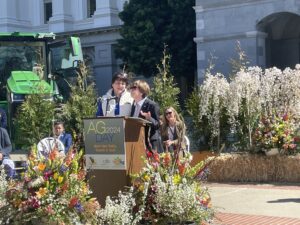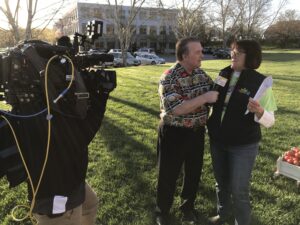Growing Together Summer 2024
California Foundation for Agriculture in the Classroom Delivers Ag Literacy and Inspiration to Students Statewide
California Ag in the Classroom “went viral” before “going viral” was even part of the average American’s vocabulary.
Long before social media, Judy Culbertson was part of the program that would soon become a model of sharing information and experience with those who would otherwise never have such opportunities. In the early 1980s, Culbertson started taking the farm to the classroom. More than four decades later — and with support from Grow West since day one — that effort and the organization supporting it continues to gain steam. Today, the California Foundation for Agriculture in the Classroom is connecting more students and teachers than ever with California’s number-one industry of agriculture.
“Our first signature activity was San Francisco Farm Day, where we had 10 groups of farmers from 10 different counties go to San Francisco to show farm animals and share presentations. We reached 10,000 kids that day,” Culbertson said of the first formal event in 1980. “Soon, the Glendale Unified School District called and wanted to have an event there. So we expanded to Southern California. We were quickly telling ourselves the equivalent of ‘this thing’s going viral.’”
Agriculture as a teaching vehicle around the state
That’s how California Ag in the Classroom shot out of the gate. Underpinned by the basic idea of instructing urban teachers and students about the importance of California agriculture, Ag in the Classroom set out to spread the word and grow the organization born out of the California Farm Bureau Federation. But it wasn’t just a group of people with a passion for sharing ag literacy with students. Culbertson saw the organization as a way to integrate first-hand experience from the state’s farmers into K-12 curricula around the state.

“We don’t want agriculture to be a whole separate subject. Agriculture fits nicely in all subject areas — math, science, nutrition, English and social studies. Teachers are so busy that they don’t have time to learn all about agriculture to take to their students. And many teachers are early in their careers and have never been on a farm, just like their students. We want to make it easy to incorporate agriculture into everyday learning,” said Culbertson, who retired from her executive director position at the California Foundation for Agriculture in the Classroom, a 501(c)(3) non-profit organization, in April 2024. “Teachers can talk about how weather affects crops in science classes. They can graph the growth of crop plants in math classes. They can read some of the many books about agriculture in English classes. They can talk about nutrition, food and its origins in health classes. There are so many ways to apply agriculture to basic class work.”
How Grow West is involved in California Ag in the Classroom
Efforts like these were a natural fit for Grow West, who has been a financial supporter of California Ag in the Classroom from day one. Longtime friend of Culbertson’s and Chairman of the Grow West Board of Directors Les Lyman — who says the company’s been involved in Ag in the Classroom “as long as we’ve been in business in California” — gradually grew his support for the effort to educate students about agriculture with a single goal.
“We are changing both students’ and teachers’ perspectives on how their food and fiber is produced and where it comes from. It’s not just off the shelf of a grocery store,” Lyman said. “At Grow West, we share Judy’s enthusiasm and energy for the program.”
Why agriculture is so important to early education
Culbertson has led extensive efforts both in and out of the classroom. She recalls when ranchers have driven cattle trailers across the Oakland Bay Bridge and when teachers have taken students on field trips miles outside their urban neighborhoods. Combined with an array of classroom resources — all available to teachers and schools free of charge — like a student newspaper and downloadable posters and information, these farmer-student interactions have helped many of the state’s 7 million students learn about agriculture. Such ag literacy yields a new, realistic and more positive perspective.
“As students grow up, they can either be fed misinformation about agriculture, or good, solid information from us,” Culbertson said. “If we’re not there to share information and help create appreciation and wonder about food, students won’t pay any attention and will grow up thinking their food comes from the grocery store. They won’t know about the importance of sustaining our farms and farmland and why that is so critical to the future for all of us.”
Grow West’s role in California Ag in the Classroom
California Ag in the Classroom is part of the national network of similar state organizations with a common mission to equip teachers with resources to integrate agriculture into everyday classwork. Like in other states, the California program relies on support from agricultural organizations. While it’s unique in how it’s operated through an independent foundation whereas other state groups operate through organizations like Cooperative Extension, California Ag in the Classroom derives physical and financial support from partners like Grow West who share its passion for ag literacy.

“The focus may be on the kids, but the teacher’s more important from the standpoint of integrating ag literacy into the long-term educational process. Whether they incorporate that into their next syllabus or they just know more about it, they’ll always have that knowledge,” Lyman said. “That education is pretty important when you see that kind of response and commitment coming from the urban teachers when they see how farms produce what we’re eating and wearing. California Ag in the Classroom is doing a good job of making that happen, and that’s why we have financially supported the organization since it started.”
The future of ag literacy in California
Looking forward, Lyman and Culbertson agreed the mission of California Ag in the Classroom will continue to grow in importance, even in smaller communities around the state. But Culbertson — who still has contact with some of the first students involved in the programs she started over 40 years ago — said with support from Lyman, Grow West and others in the industry, the “small but mighty” organization will continue to grow and evolve as needed to keep spreading ag literacy around the state.
“With all of the innovation in agriculture today, we have new opportunities to engage students in our industry at a time when we need more people entering agricultural careers,” she said. “With support from people like Les, who supports us without having to even ask, we will continue to reach beyond our agricultural world and provide solid information so that ag literacy continues to grow in our state.”
California Ag in the Classroom partners have a range of options to support the organization and its work, from providing financial contributions to hosting or volunteering at special events. To find out how you can get involved in California Ag in the Classroom, go online to learnaboutag.org/help.
